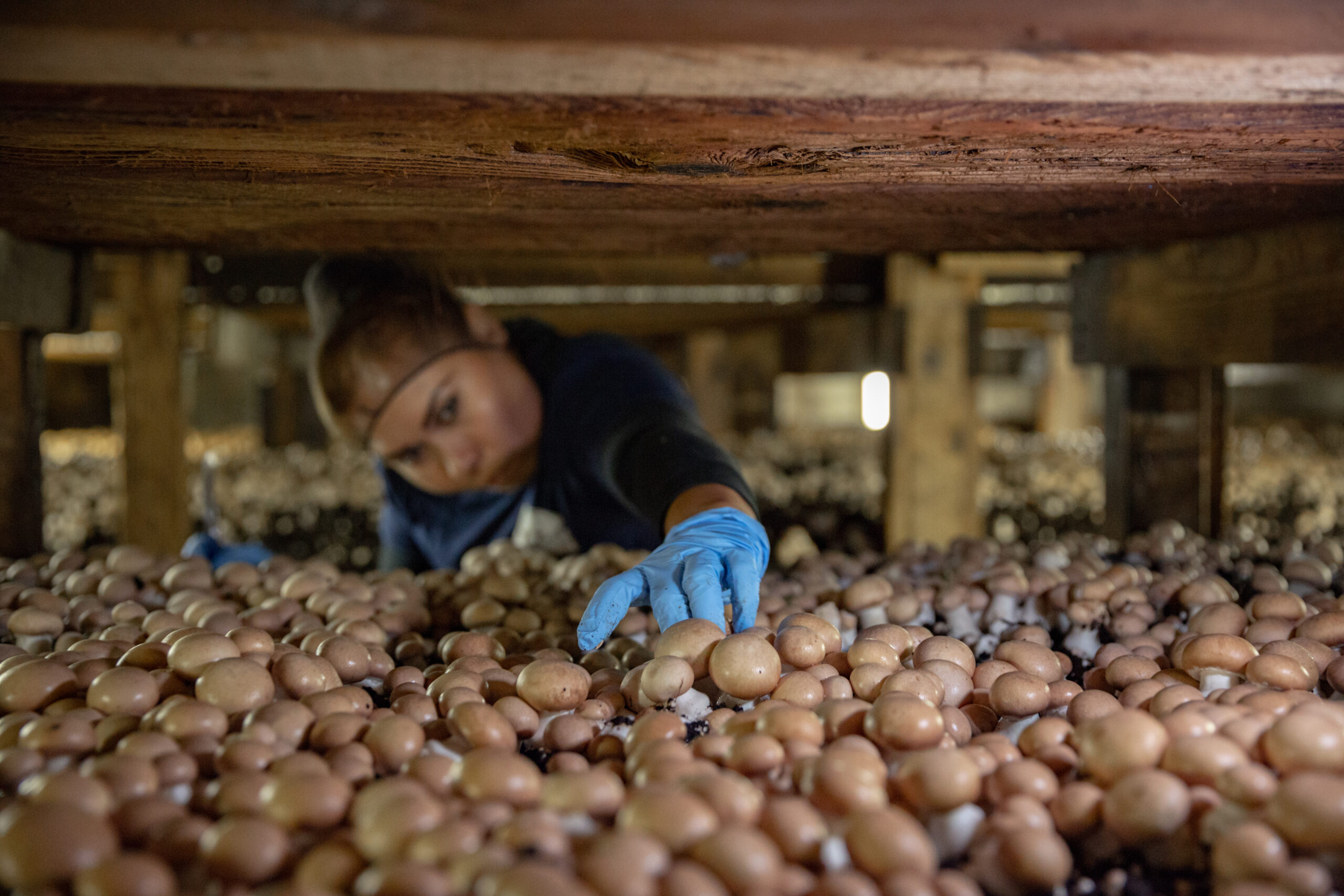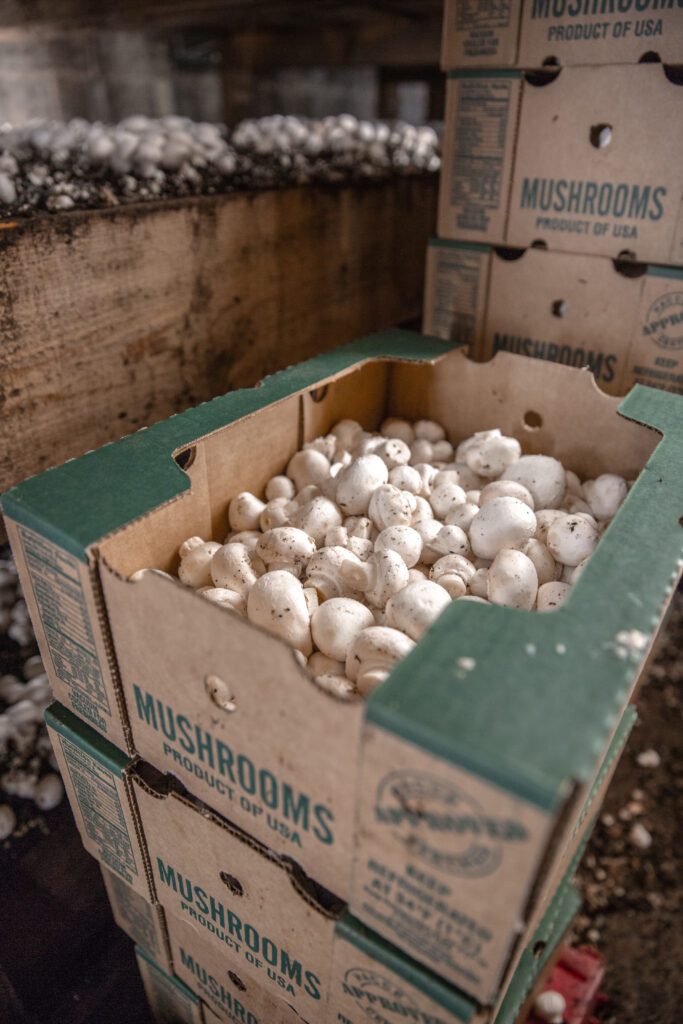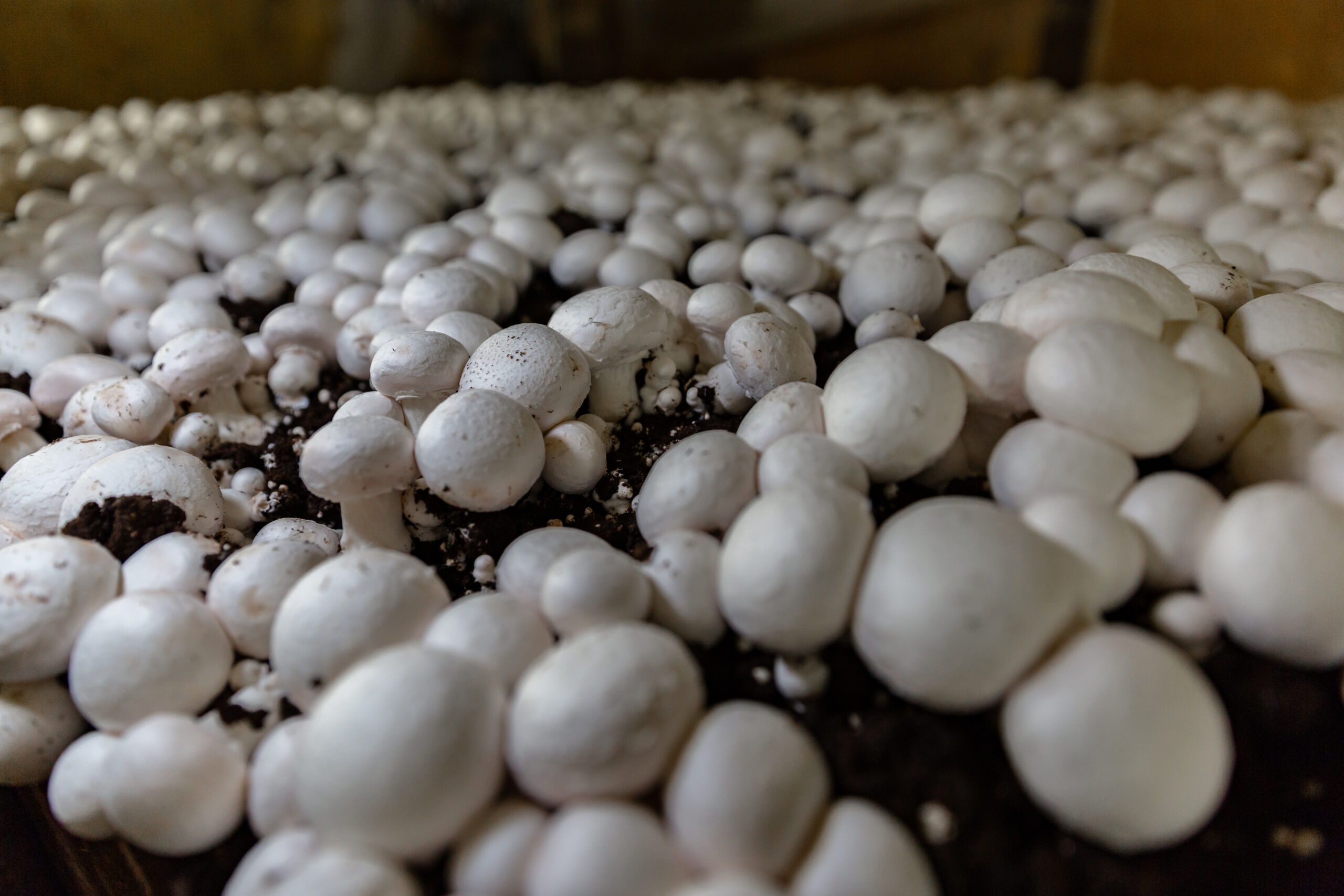
Mushrooms are grown in darkness, emerging from compost made from the byproducts of other agricultural production systems—a uniquely sustainable, closed-loop process.
Image courtesy of American Mushroom.
As a food crop, mushrooms are a contradiction. They are fungi, not plants; they have fruiting bodies, but aren’t fruit; they are grown in darkness, not in sunlight, and they require a special growing media that comes with a set of regulations not required of any other crop. Mushrooms also have a very short shelf life, are highly temperature sensitive, and are easily damaged. At the same time, mushrooms are one of the most sustainably grown crops. The crop cycle is a closed loop; organic materials such as manure, crushed corn cobs, late hay, or straw from farmers’ fields are used to make the compost in which the mushrooms are grown. Eight to twelve weeks later, that same compost is picked up by farmers to spread on their fields to improve the soil for their crops and pasturelands. Some mushroom growers bag the used compost for sale in garden centers.
It’s a message Rachel Roberts would like more people to know. As American Mushroom‘s (AMI) president, she represents mushroom growers, processors, and marketers of cultivated mushrooms in the United States and industry suppliers worldwide. AMI is involved in legislative and regulatory issues as well as research and innovations within the mushroom industry. Additionally, AMI develops best practices for food safety, integrated pest management, and worker safety, and provides a communication network for all industry partners.
Helping Mushroom Growers Succeed

Roberts is also on IR-4’s Commodity Liaison Committee (CLC), a vital part of keeping IR-4 connected to specialty crop growers. She says IR-4 plays an essential role for specialty crops and is a tremendous resource in the intersection between research, regulations, and manufacturers making the products.
“Specialty crops are strong industries, but we don’t have millions of dollars to work with manufacturers to do the research that would allow our crop to use their pesticides or to prove that certain pesticides should be allowed to be used in organic production,” Roberts says. “It’s too expensive for a single small industry, like mushrooms, to pay for the research needed to register a product for their crop. And it’s not worth it to the manufacturers because they will never make that money back since the crop isn’t a large commodity crop.”
The knowledge and experience of IR-4 advisors are also valuable resources for specialty crop industries and cannot always be obtained elsewhere. Roberts relies on her CLC colleagues for help when issues arise and says they are the reason she joined the committee.
“We recently had an input [for mushroom crops] stopped at the port, and the grower importing the product called me for advice,” Roberts says. “This grower is a multi-million-dollar company with lawyers and government affairs people, but they were stymied. I said, ‘We have to talk to IR-4,’ and they said, ‘What’s IR-4?” I reached out to Michael Braverman, Biopesticide Program Manager at IR-4, and Jerry Baron, Executive Director of IR-4, and got an answer to their problem so quickly. The grower was really impressed with me, although I just knew who to email, not the answer. This is a company backed by millions of dollars of venture capitalist money that is doing a lot of innovative work with mushrooms. But they had never heard of IR-4.”
When Roberts called, Braverman and Baron were able to quickly find the research on the particular residue and interpret why it was causing an issue. Roberts said the USDA considered it a nematicide, and the concern was over killing beneficial nematodes. “Jerry [Baron] and Michael [Braverman] were able to find the missing gaps and help the grower through the issue, which was invaluable,” Roberts says.
Roberts calls mushrooms “the Swiss watches” of agriculture, noting that they serve many functions, but you won’t get the yield you need if just one thing is off. The growing media is all-important. Not only does it have its own unique set of pathogens and insects, but it is also closely regulated for contamination. Since the compost is made from a lot of material from farmers’ fields, residues from grazing animals (and what they eat), fertilizer, and pesticides are all possible problems. This means mushroom farmers have to know their sources and work with them on what residues are permitted. Roberts half-jokingly says, “I work for American Mushroom, but I could say I work for American Mushroom Compost because 50 percent of my job is protecting that compost by educating regulators about how mushroom growers use and dispose of it.”
Roberts cites a recent incident where a garden company had tomatoes impacted by a residue, so it sued the soil company. The soil company sued the mushroom grower who sold them the mushroom compost. It turned out the residue came from the straw in the compost, and it wasn’t a banned substance for straw and the state didn’t have a requirement about its use for mushroom compost. However, the mushroom grower had to decide whether they would source straw from another supplier or not sell the compost to that gardening company after use.
“Selling the used compost is a core part of many mushroom growers’ business, so that would have been a huge loss,” Roberts says. “Then their insurance company said it would not insure them if they continued to buy from that straw supplier. So it’s vitally important to understand all of the inputs that go into the mushroom compost all the way up the supply chain—and to know what is allowed at the end of the supply chain.”
IR-4 played an essential role in helping that grower.
Preserving an Important Fungicide
Another example where IR-4 provided critical assistance was when the U.S. Environmental Protection Agency (EPA) came down with a regulation on thiabendazole (the active ingredient in Mertect), a fungicide mushroom growers use to control green mold—a significant pathogen for mushrooms. The EPA rule said Mertect could not be used on any crop where the spent mushroom compost would be spread on land for pasture or row crops whose end products were for human or livestock consumption—again a blow for growers who would also suffer substantial crop losses from green mold if they could not use Mertect but who also rely on the income from the used compost. IR-4 advised what research needed to be done to prove to the EPA that Mertect was safe to use in this way.

Button mushrooms (Agaricus bisporus)–the white and brown ones commonly seen in grocery stores—make up 85% of the mushroom market in the U.S. Image courtesy of American Mushroom.
Staying Connected to the Mushroom Market
Button mushrooms (Agaricus bisporus)–the white and brown ones commonly seen in grocery stores—make up 85% of the mushroom market in the U.S. The other 15% are specialty mushrooms. Most mushrooms are for eating, but others are known as “functional,” meaning they are for powders, pills, tinctures, and other medicinal and health uses. All mushrooms sold in the U.S. are grown domestically, with 70% concentrated in Chester County, Pennsylvania. The many surrounding farms both supply inputs for and use the mushroom compost. The U.S. doesn’t export mushrooms — everything produced here gets consumed. Imported mushrooms are always frozen because the shelf life for fresh product is so short. In the 2023-2024 survey by the National Agricultural Statistics Service, the entire U.S. mushroom industry was valued at $1 billion—643 million pounds of mushrooms.
Roberts grew up in Chester County, so mushrooms have always been part of her life. “I was lucky that my predecessor who did government relations understood the value of IR-4 and was a champion for them in Washington, D.C.,” Roberts says. “She had a seat on the CLC ready for me to take over, and I’m so grateful for that. On the CLC, we learn about all of our specialty crops, and while some have unique needs, many overlap, and we can help each other.”
Additional IR-4 mushroom work can be explored in the IR-4 Food Crops Database by entering “mushroom” in the simple search commodity field.
